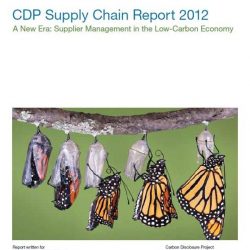CDP Supply Chain Report 2012

Climate change has become a mainstream business issue, and large global corporations are now extending their gains in internal carbon management to the next opportunity: their supply chain. Carbon Disclosure Project (CDP) has been collecting data on corporate greenhouse-gas (GHG) emissions for almost a decade. Global companies that have been exposed to these information requests for many years understand the value of measuring and reporting their emissions, and they are now pushing their suppliers to report more climate change-related information and take greater action to reduce their emissions. This represents a much larger opportunity: indirect emissions (meaning those from the supply chain) represent as much as 86% of a company’s total emissions.
In 2011, CDP conducted its fourth annual information request for member companies and their suppliers, and describes its findings in this report, published in collaboration with Accenture. The results indicate that companies are making real changes to their operating models, most frequently in procurement, resulting in greater reductions in greenhouse-gas emissions and greater monetary gains across the entire supply chain. Of the 49 CDP Supply Chain member companies—the companies who are requesting climate information from their suppliers—90% of responding companies have a climate change strategy with at least general guidelines for procurement, an increase from 79% in 2010 and 74% in 2009. Some 62% reward suppliers that employ good carbon-management practices (up from 19% in 2009 and 28% in 2010), 39% will soon begin deselecting suppliers that do not adopt such measures (compared to 17% in 2009 and 23% in 2010), and 30% factor climate change into their evaluation of suppliers. These have all increased significantly over prior years, which shows growing momentum for supply chain engagement. Monetization of these efforts remains a significant challenge: only 20% of responding companies report an estimated monetary value for the supply chain initiatives they have undertaken to improve carbon management.
The results also indicate that suppliers are becoming more transparent about their emissions-related information, in part due to growing pressure from corporate clients. In 2011, 1,864 suppliers responded to the information request, a substantial increase from prior years (1,000 in 2010, and 715 in 2009). This parallels the way that sustainability measures have become more prevalent in the business community at large. Over the past decade, major global corporations have increasingly taken steps to address climate change, partly in response to greater awareness of climate change among investors and consumers.
Now, suppliers are realizing the business value for emissions information due to growing requests for such information among their corporate clients. The business case is strong and growing: suppliers that do not measure, quantify, and manage their greenhouse-gas emissions will soon see their business move to competitors that can provide better information and clearer evidence of change. At the same time, while disclosure is strong among global suppliers—67% of suppliers that responded to the information request report scope 1 and scope 2 emissions— these companies must build on this foundation of communication and begin taking meaningful actions to reduce their emissions. While 43% of CDP Supply Chain member companies have achieved reductions in their GHG emissions, only 28% of their suppliers have.
Finally, the survey results indicate ways in which corporations can serve as a catalyst for these changes among their suppliers, working to engender sound carbon-management practices among their suppliers. While the opportunity is clear, the precise means of capturing these gains are not. Some 39% of companies have realized monetary savings from their own emissions reductions activities and over a third (34.5%) have benefited from new revenue streams or financial savings as a result of their suppliers’ carbon reduction activities. However, less than a quarter (24%) help their suppliers to quantify the return on their low-carbon investments. The next step is to more effectively evaluate suppliers, improve performance through more effective procurement, and improve the tools and metrics used to quantify and monetize the gains from emissions reductions. Executed correctly, supply-chain engagement will not simply generate benefits for the environment but for the balance sheet as well.





